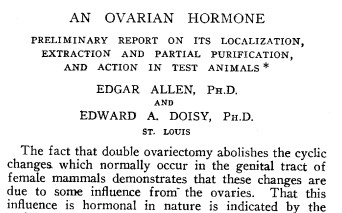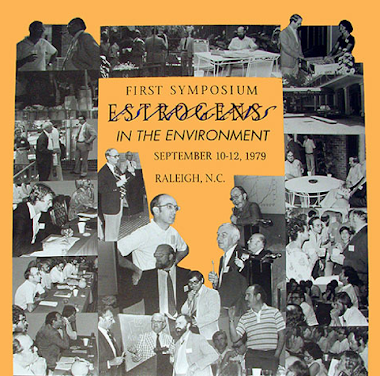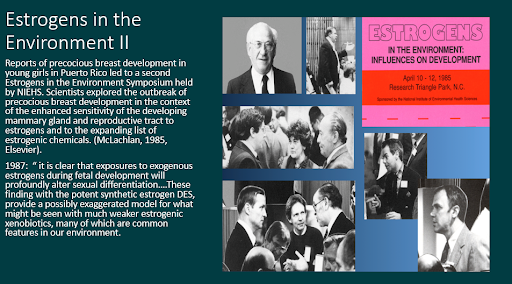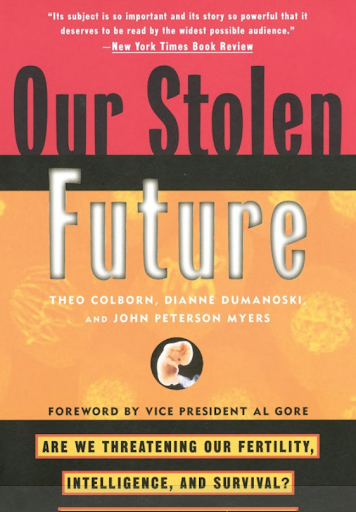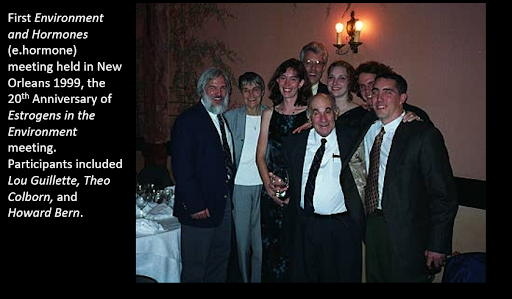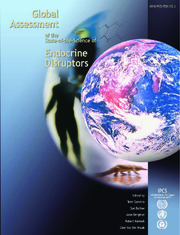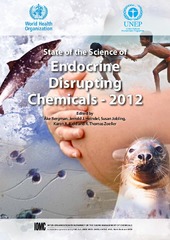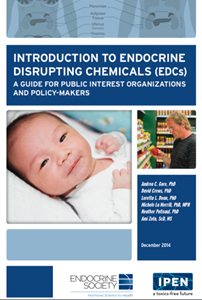1872 Polyvinyl chloride (PVC) synthesized by German chemist Eugen Baumann.
Baumann, E. (1872)“Ueber einige Vinylverbindungen” (On some vinyl compounds), Annalen der Chemie und Pharmacie, 163: 308–322.
1874 DDT synthesized by Austrian chemist Othmar Zeidler.
1876 Polychlorinated biphenyls (PCBs) synthesized by German chemist Oscar Doebner.
Doebner, O.G. (1876) “Constitution der Diphenyldisulfosäure und ihrer Umwandlungsprodukte,” Berichte der deutschen chemischen Gesellschaft. 9 (1): 129–131.
1891 Bisphenol A (BPA) synthesized by Russian chemist Aleksandr Dianin.
Reported in a scientific paper in 1905 by Theodor Zincke from Marburg University, Germany.
1900 PVC use attempted by Ivan Ostromislensky and Fritz Klatte of the German chemical company Griesheim-Elektron. Both attempted to use PVC in commercial products, but difficulties in processing the rigid, sometimes brittle polymer thwarted their efforts.
Semon, W. L., and Stahl, G. A. (1981). History of Vinyl Chloride Polymers. Journal of Macromolecular Science: Part A – Chemistry, 15(6), 1263–1278.
1904 Lead paint linked to childhood lead poisoning by Australian J. Lockhart Gibson, one of the the first to do so.
Markowitz, G. and Rosner, D. (2000). “Cater to the Children”: The Role of the Lead Industry in a Public Health Tragedy, 1900-1955. Am J Public Health. 90(1), 36–46.
1907 Bakelite, the first successful commercial synthetic plastic, synthesized by chemist Leo Baekeland (“The Father of the Plastics Industry”) in Yonkers, New York.
1923 The hormone estrogen identified
Allen, E. and E.A. Doisy. (1923). An ovarian hormone: Preliminary report on its localization, extraction and partial purification and action in test animals. Journal of the American Medical Association, 81:819.
1929 Commercial production of PCBs by Swann Chemical Company and then in 1935 by Monsanto Chemical Company, with manufacturing taking place in Anniston, Alabama.
Kodavanti, P. (2017). Polychlorinated Biphenyls (PCBs). Neuroscience and Biobehavioral Psychology. Elsevier, Amsterdam, Holland.
1929 The hormone progesterone identified
Corner G.W., and Allen, W.M. (1929). “Physiology of the Corpus Luteum, II: Production of a Special Uterine Reaction (Progestational Proliferation) by Extracts of the Corpus Luteum.” American Journal of Physiology. 88 326–339.
Piette, P. (2018). The history of natural progesterone, the never-ending story. Climacteric, 21(4), 308–314.
1930 Fluorocarbons synthesized and commercialized over the next few years as refrigerants by the Kinetic Chemical Corporation.
Plunkett, R.J. (1986). The History of Polytetrafluoroethylene: Discovery and Development. In: Seymour, R.B., Kirshenbaum, G.S. (eds) High Performance Polymers: Their Origin and Development. Springer, Dordrecht.
1933 PVC blended with additives, including phthalates, to make it into a useful plastic by Dr. Waldo Semon and the B.F. Goodrich Company.
US patent 1929453, Waldo Semon, “Synthetic rubber-like composition and method of making same,” published 1933-10-10, assigned to B.F. Goodrich
1936 Twenty estrogenic chemicals identified, including BPA and estrone.
Dodds, E. C. and Lawson, W. (1936). Synthetic oestrogenic agents without the phenanthrene nucleus. Nature 137: 996.
1937 Structure of the steroid hormones determined and found that high doses of androgens, estrogens or progesterone could inhibit ovulation in animals.
Makepeace, A. W., Weinstein, G. L., & Friedman, M. H. (1937). The effect of progestin and progesterone on ovulation in the rabbit. American Journal of Physiology, 119(3), 512-516.
1937 Possible health effects of PCBs and chlorinated naphthalenes discussed in several medical cases and papers, related to occupational exposures. It was determined that the effects were limited to the liver, were limited to high doses, and the toxicity was lower than lead or benzene.
Drinker CK, Warren MF, Bennett GA (1937). “The problem of possible systemic effects from certain chlorinated hydrocarbons.” Journal of Industrial Hygiene and Toxicology. 19 (7): 283–311.
Butler DA (2005). “Connections: The Early History of Scientific and Medical Research on ‘Agent Orange.'” Journal of Law and Policy. 13 (2): 527–542.
1938 Synthetic estrogen diethylstilbestrol (DES) created by Dr. Leon Goldberg and Sir Edward Charles Dodds. DES was first prescribed to supplement a pregnant woman’s natural estrogen production, and approved by the FDA in 1941. In the U.S., an estimated 5-10 million people were exposed to DES between 1938-1971.
Dodds, E., Goldberg, L., Lawson, W. et al. (1938). OEstrogenic Activity of Certain Synthetic Compounds, Nature, 141, 247–248.
Nancy Langston, (2010). Toxic Bodies: Hormone Disruptors and the Legacy of DES. Yale University Press, New Haven, CT; DES Action timeline.
1939 DDT used as an insecticide. Swiss chemist Paul Hermann Müller discovered that DDT had insecticidal properties. DDT was initially used to successfully combat malaria, typhus, and other diseases among both military and civilian populations, and then used for insect control in crop and livestock production, homes, and gardens.
1941 Teflon patented by Kinetic Chemicals, a partnership of General Motors and DuPont. DuPont began marketing the polymer commercially in 1944 and filed to trademark it under the name of Teflon in February 1945.
Hagley Museum and Library. On this date (February 4) in 1941, Kinetic Chemicals, Inc., a…
World War 2 Widespread use of chemicals
1945 Rachel Carson proposes to write a story on the impact of DDT on fish and wildlife to Reader’s Digest, but was turned down.
Source: Rachel Carson to Harold Lunch, July 15, 1945, Rachel Carson Papers, Beinecke Library, Yale University. Cited in Douglas Brinkley, D. (2022). The Silent Spring Revolution, Harper Collins, New York, p. 51.
1947 DES granted FDA approval for use as a miscarriage preventative (it was used earlier than this off-label).
Smith O. W. (1948). Diethylstilbestrol in the prevention and treatment of complications of pregnancy. American journal of obstetrics and gynecology, 56(5), 821–834.
1948 Nobel Prize in Physiology or Medicine awarded to Paul Hermann Müller “for his discovery of the high efficiency of DDT as a contact poison against several arthropods.”
1950 DDT shown to disrupt sexual development in roosters, and “may exert an estrogen-like action.”
Burlington H, Lindeman VF. Effect of DDT on Testes and Secondary Sex Characters of White Leghorn Cockerels. Proceedings of the Society for Experimental Biology and Medicine. 1950;74(1):48-51.
1953 DES sales peaked, then declined after it was shown to be ineffective to prevent miscarriage in a controlled, randomized, double-blind study. “Even so, DES continued to be prescribed during pregnancy until 1971, in large part because pharmaceutical companies discredited the study and heavily promoted DES to doctors.”
Dieckmann, W.J. , Davis, M. E., Rynkiewicz, L. M., and Pottinger, R. E. (1953). Does the administration of diethylstilbestrol during pregnancy have therapeutic value? American journal of obstetrics and gynecology, 66(5), 1062–1081.
Source: DES Action timeline
1956-1960 Birth control pills tested in a clinical trial on Puerto Rican women in 1956. Available commercially for “menstrual disorders” in 1957 and FDA approved for contraception in 1960.
Garcia, C. R., Pincus, G., and Rock, J. (1956). Effects of certain 19-nor steroids on the normal human menstrual cycle. Science (New York, N.Y.), 124(3227), 891–893.
Pincus, G., Rock, J., Garcia, C. R., et al. (1958). Fertility control with oral medication. American journal of obstetrics and gynecology, 75(6), 1333–1346.
1959 FDA banned DES for chickens after high DES levels in poultry produced side effects, such as male breast growth in humans.
Source: DES Action timeline
1962 Silent Spring, by Rachel Carson published. This seminal book focused on DDT, other pesticides and other synthetic chemicals causing eggshell thinning, deformities and population declines in wildlife.
1962 Agent Orange sprayed in Southeast Asia by the U.S. military from 1962 to 1971 during the Vietnam War to remove the leaves of trees and other dense tropical foliage. It was contaminated with dioxin.
1963 DDT production peaked in the U.S.
1964 Early life exposure to estrogen caused cancerous changes in mice.
Takasugi, N., Bern, H. A. (1964). Tissue Changes in Mice With Persistent Vaginal Cornification Induced by Early Postnatal Treatment With Estrogen, JNCI: Journal of the National Cancer Institute, 33(5), 855–865.
1966 The National Institute of Environmental Health Sciences (NIEHS) began as the Division of Environmental Health Sciences within the NIH. In 1969, the division was elevated to full NIH institute status.
1968 Yushō disease mass poisoning in Japan when rice bran oil produced by the Kanemi Company was contaminated with PCBs and polychlorinated dibenzofurans (PCDFs), leading to endocrine-related health effects.
Aoki Y. (2001). Polychlorinated biphenyls, polychlorinated dibenzo-p-dioxins, and polychlorinated dibenzofurans as endocrine disrupters–what we have learned from Yusho disease. Environmental research, 86(1), 2–11.
1969 Cuyohoga River burns in Ohio, raising environmental awareness.
1970 First Earth Day
1970 EPA established
1970 PCB production peaks in the U.S.
1971 Mrs. Penny Stone questioned her doctor as to whether DES had caused her daughter’s cancer, and after denials, the doctors finally decided to investigate. This led to the important publication finding that the daughters of DES treated mothers had an increased risk of a rare vaginal cancer. FDA recommended not prescribing DES during pregnancy, but did not ban it.
Herbst, A. L., Ulfelder, H., & Poskanzer, D. C. (1971). Adenocarcinoma of the vagina. Association of maternal stilbestrol therapy with tumor appearance in young women. The New England journal of medicine, 284(15), 878–881.
DES Action: Meet the Woman who was the First to Connect DES and Cancer.
1971 Dioxin sprayed on Times Beach and Missouri horse arenas. Chemical waste from a local factory was mixed with waste motor oil and sprayed as a dust-suppressant on the roads of Times Beach and in horse arenas. Tetrachlorodibenzodioxin (TCDD) was later identified as the culprit that sickened humans and killed dozens of horses and many other animals at the horse arenas. The town of Times Beach was evacuated in 1983 and is now a “ghost town.”
Carter, C. D., Kimbrough, R. D., Liddle, J. A., Cline, R. E., Zack, M. M., Jr, Barthel, W. F., Koehler, R. E., & Phillips, P. E. (1975). Tetrachlorodibenzodioxin: an accidental poisoning episode in horse arenas. Science (New York, N.Y.), 188(4189), 738–740
1972 Lead found to affect IQ. Herbert Needleman, M.D. led pioneering studies providing first clear evidence that lead, even at very low levels, could affect a child’s IQ. Studies by other researchers established the role of low levels of lead in behavioral and neurological disorders. NIEHS support for continued research on the effects was key to establishing limits and, ultimately, bans on lead in gasoline and paint.
Needleman, H. L., Tuncay, O. C., & Shapiro, I. M. (1972). Lead levels in deciduous teeth of urban and suburban American children. Nature, 235(5333), 111–112.
1972 DDT banned for use in the U.S., a decision upheld by courts in 1973.
DDT Ban Takes Effect (EPA).
1973 Michigan PBB incident. A flame retardant mixture of polybrominated biphenyls (PBBs), was accidentally added to livestock feed distributed throughout Michigan. People ate the contaminated food until the animals were culled. Studies continue to find effects in the grandchildren of people who consumed the tainted food.
Carter L. J. (1976). Michigan’s PBB Incident: Chemical Mix-Up Leads to Disaster. Science (New York, N.Y.), 192(4236), 240–243.
Egginton, J. (2009). The Poisoning of Michigan. Michigan State University Press.
Some of the most important findings to come out of the PBB study include associations with:
Early puberty:
Blanck, H. M., Marcus, M., Tolbert, P. E., Rubin, C., Henderson, A. K., Hertzberg, V. S., Zhang, R. H., & Cameron, L. (2000). Age at menarche and tanner stage in girls exposed in utero and postnatally to polybrominated biphenyl. Epidemiology (Cambridge, Mass.), 11(6), 641–647.
Urinary/genital problems:
Small, C. M., DeCaro, J. J., Terrell, M. L., Dominguez, C., Cameron, L. L., Wirth, J., & Marcus, M. (2009). Maternal exposure to a brominated flame retardant and genitourinary conditions in male offspring. Environmental health perspectives, 117(7), 1175–1179.
Miscarriage:
Small, C. M., Murray, D., Terrell, M. L., & Marcus, M. (2011). Reproductive outcomes among women exposed to a brominated flame retardant in utero. Archives of environmental & occupational health, 66(4), 201–208.
Breast cancer:
Terrell, M. L., Rosenblatt, K. A., Wirth, J., Cameron, L. L., & Marcus, M. (2016). Breast cancer among women in Michigan following exposure to brominated flame retardants. Occupational and environmental medicine, 73(8), 564–567.
Birth outcomes:
Terrell, M. L., Hartnett, K. P., Lim, H., Wirth, J., & Marcus, M. (2015). Maternal exposure to brominated flame retardants and infant Apgar scores. Chemosphere, 118, 178–186.
1975 The Kepone disaster in Hopewell, Virginia. Workers at Life Science Products Company were poisoned while making the pesticide Kepone (chlordecone). Kepone and its waste materials were dumped into the James River and its tributaries from 1966 to 1975 by Allied Chemical Company and LifeSciences Product Company.
Toxic Dust: The History and Legacy of Virginia’s Kepone Disaster, Virginia Museum of History and Culture.
1976 Seveso Disaster. An industrial accident that resulted in the release of toxic chemicals and high exposure to TCDD to residents in and near Seveso, Italy. Health effects are still being studied, and include mortality, diabetes, cancer, neonatal thyroid function, and lower sperm counts.
Eskenazi, B., Warner, M., Brambilla, P., Signorini, S., Ames, J., & Mocarelli, P. (2018). The Seveso accident: A look at 40 years of health research and beyond. Environment international, 121(Pt 1), 71–84.
1976 Toxic Substances Control Act (TSCA) enacted; it grandfathered in thousands of unevaluated chemicals in commerce at the time.
1977 Pesticide workers develop infertility. A number of cases of infertility were discovered among men working in a California pesticide factory. The suspected cause was exposure to the chemical 1,2-dibromo-3-chloropropane (DBCP).
Whorton, D., Krauss, R. M., Marshall, S., & Milby, T. H. (1977). Infertility in male pesticide workers. Lancet (London, England), 2(8051), 1259–1261.
1977 CPSC bans brominated tris. The Consumer Product Safety Commission banned children’s pajamas treated with the flame retardant brominated tris (tris (2,3-dibromopropyl phosphate), in part due to work by Dr. Arlene Blum.
Blum, A., & Ames, B. N. (1977). Flame-retardant additives as possible cancer hazards. Science (New York, N.Y.), 195(4273), 17–23. [full text link]
1978 Additional flame retardants banned. The flame retardant tris-(1,3-dichloro-2-propyl)-phosphate (TDCPP), a “regrettable substitute” for brominated tris, was found to be a carcinogen, and also banned from children’s pajamas. It is still in widespread use in other products.
Gold, M. D., Blum, A., & Ames, B. N. (1978). Another flame retardant, tris-(1,3-dichloro-2-propyl)-phosphate, and its expected metabolites are mutagens. Science (New York, N.Y.), 200(4343), 785–787.
1978 National DES Task Force created by the U.S. Secretary of the Department of Health, Education & Welfare. It was charged with reviewing all aspects of the DES problem and with making recommendations for research and health care of the people exposed. DES Action USA was founded and incorporated, as a national non-profit consumer group for individuals exposed to DES.
1979 First “Estrogens in the Environment” symposium at NIEHS, organized by Dr. John McLachlan. The objectives were to “determine what an estrogen is, how it works, and what effect estrogenic substances might have on human health.”
1979 Manufacture of PCBs banned and uses curtailed in U.S.
EPA Bans PCB Manufacture; Phases Out Uses (EPA Press Release)
1979 Yucheng Rice Oil Contamination. In Taiwan, PCBs and PCDFs leaked into rice oil and intoxicated 2000 people who had consumed the oil, leading to numerous health effects.
Guo, Y. L., Lambert, G. H., Hsu, C. C., & Hsu, M. M. (2004). Yucheng: health effects of prenatal exposure to polychlorinated biphenyls and dibenzofurans. International archives of occupational and environmental health, 77(3), 153–158.
1980 Environment linked to cancer at Copenhagen workshop organized by Dr. Niels Skakkebaek. Dr. Johannes Clemmesen, who created the first national cancer registry in Denmark, presented evidence of environmental maternal exposures as a risk factor for testicular cancer.
Skakkebaek, N. (1981). Early detection of testicular cancer : proceedings of a workshop held in Copenhagen, Denmark on November 5-7 1980. International journal of Andrology. Supplement. 4.
1980-1981 Important papers published
Long-term effects on the female mouse genital tract associated with prenatal exposure to diethylstilbestrol. McLachlan JA, Newbold RR, Bullock BC. Cancer Res. 1980 Nov;40(11):3988-99.
The estrogenic activity of DDT: in vivo and in vitro induction of a specific estrogen inducible uterine protein by o,p’-DDT. Stancel GM, Ireland JS, Mukku VR, Robison AK. Life Sci. 1980 Sep 22;27(12):1111-7.
DDT-induced feminization of gull embryos. Fry DM, Toone CK. Science. 1981 Aug 21;213(4510):922-4.
1981 First annual International Dioxin Symposium held in Rome.
1984 Birth defects linked to Agent Orange exposure in veterans’ babies.
Vietnam veterans’ risks for fathering babies with birth defects. Erickson JD, Mulinare J, McClain PW, Fitch TG, James LM, McClearn AB, Adams MJ Jr. JAMA. 1984 Aug 17;252(7):903-12.
1985 Estrogens in the Environment II: Influences on Development Symposium, organized by Dr. John McLachlan.
Schiff I, Ravnikar VA. Estrogens in the Environment II: Influences on Development. JAMA. 1987;258(10):1397.
1985 EPA classified TCDD as a likely human carcinogen
Source: Dioxin (Environmental Working Group).
1990 Great Lakes, Great Legacy? by Dr. Theo Colborn: book published detailing developmental, reproductive, metabolic and behavioral damage to Great Lakes wildlife from persistent chemical pollutants. Dr. Colborn, who received her PhD at age 58, was the founder of the EDC field.
Theo Colborn, Alex Davidson, Sharon Green, R.A. (Tony) Hodge; C. Ian Jackson, Richard A. Liroff, Great Lakes, Great Legacy? (Washington, D.C.: The Conservation Foundation, 1990).
1991 Wingspread conference organized by Drs. Theo Colborn and Pete Myers resulted in the Wingspread Consensus Statement. At the meeting Dr. Myers coined the term endocrine disruptor. This conference marked the beginning of the endocrine disruption field.
Dr. Colborn discusses organizing Wingspread:
1991 Dr. Ana Soto wonders why breast cancer cells are proliferating in the new test tubes purchased for her lab. She identifies the problem as the estrogenic compound nonylphenol leaching from the plastic tubes.
p-Nonyl-phenol: an estrogenic xenobiotic released from “modified” polystyrene. Soto AM, Justicia H, Wray JW, Sonnenschein C. Environ Health Perspect. 1991 May;92:167-73.
1991 Second assessment of dioxin initiated by EPA. EPA administrator Bill Reilly tells The New York Times: “We are now seeing new information on dioxin that suggests a lower risk assessment for dioxin should be applied” (Schneider 1991).
Johnson J. (1995). Dioxin risk: are we sure yet? Environmental science & technology, 29(1), 24A–5A. pdf.
1991 Impact of the Environment on Reproductive Health workshop in Copenhagen, sponsored by the World Health Organization (WHO). Dr. Niels Skakkebaek presented data on increasing rates of testicular cancer with a meta analysis of semen quality. He presented the hypothesis that testicular cancer and infertility were due to poor semen quality and that congenital testicular abnormalities may be biologically linked. Dr. John McLachlan presented data on industrial estrogenic chemicals polluting the environment.
Michal, F., Grigor, K. M., Negro-Vilar, A., & Skakkebaek, N. E. (1993). Impact of the environment on reproductive health: executive summary. Environmental health perspectives, 101 Suppl 2(Suppl 2), 159–167.
1992 Important scientific publications:
Theo Colborn and Coralie Clement, eds. Chemically-Induced Alterations in Sexual and Functional Development: The Wildlife/Human Connection (Princeton, NJ: Princeton Scientific Publishing Co., 1992).
Nonneman DJ, Ganjam VK, Welshons WV, Vom Saal FS. Intrauterine position effects on steroid metabolism and steroid receptors of reproductive organs in male mice. Biol Reprod. 1992 Nov;47(5):723-9.
Dr. Howard Bern: “Extrapolating from what is known about the developmental effects of other weak estrogens, there should be concern about DES-like role these environmental estrogens could play if ingested (or inhaled) extensively by mothers during a critical period of development of their offspring in utero.”
Bern HA. The development of the role of hormones in development–a double remembrance. Endocrinology. 1992 Nov;131(5):2037-8.
First publication showing a decrease in sperm quality over time:
Carlsen E, .A. Giwercman,N. Keiding and N.Skakkebaek. Evidence for decreasing quality of semen during past 50 years. BMJ. 1992.
AhR and TCDD: The aryl hydrocarbon receptor (AhR) that binds to TCDD surprised everyone by not being a member of the steroid superfamily.
Burbach KM, Poland A, Bradfield CA. Cloning of the Ah-receptor cDNA reveals a distinctive ligand-activated transcription factor. Proc Natl Acad Sci U S A. 1992 Sep 1;89(17):8185-9.
A series of studies showing developmental harm from dioxin from Dr. Richard Peterson’s laboratory. They showed that a single maternal oral exposure to 1 µg/kg BW dioxin on gestation day 15 in rats caused multiple adverse effects later in life in male offspring.
Mably TA, Moore RW, Peterson RE. In utero and lactational exposure of male rats to 2,3,7,8-tetrachlorodibenzo-p-dioxin. 1. Effects on androgenic status. Toxicol Appl Pharmacol. 1992 May;114(1):97-107.
Mably TA, Moore RW, Goy RW, Peterson RE. In utero and lactational exposure of male rats to 2,3,7,8-tetrachlorodibenzo-p-dioxin. 2. Effects on sexual behavior and the regulation of luteinizing hormone secretion in adulthood. Toxicol Appl Pharmacol. 1992 May;114(1):108-17.
Mably TA, Bjerke DL, Moore RW, Gendron-Fitzpatrick A, Peterson RE. In utero and lactational exposure of male rats to 2,3,7,8-tetrachlorodibenzo-p-dioxin. 3. Effects on spermatogenesis and reproductive capability. Toxicol Appl Pharmacol. 1992 May;114(1):118-26.
1993 Spreading the word
Dr. Lou Guillette Jr. tells the U.S. Congress, “Every man sitting in this room today is half the man his grandfather was, and the question is, are our children going to be half the men we are?”
Assault on the Male, BBC documentary discussing the possible link between endocrine-disrupting chemicals and reproductive problems observed in both wildlife and humans worldwide.
Chlorine Chemistry Council formed by the Chemical Manufacturers Association to promote the industry’s agenda in the debate over regulating chlorine production.
BPA found to leach from laboratory flasks
Krishnan AV, Stathis P, Permuth SF, Tokes L, Feldman D. Bisphenol-A: an estrogenic substance is released from polycarbonate flasks during autoclaving. Endocrinology. 1993 Jun;132(6):2279-86.
Developmental effects of EDCs reviewed by Drs. Theo Colburn, Fred vom Saal, and Ana Soto.
Colborn T, vom Saal FS, Soto AM. Developmental effects of endocrine-disrupting chemicals in wildlife and humans. Environ Health Perspect. 1993 Oct;101(5):378-84.
1994 Estrogens in the Environment III symposium notes, “a most surprising finding was that estrogenic xenobiotics are not only found in the environment but are also contaminants (e.g., nonylphenol, BPA) of laboratory plasticware, such as flasks and petri dishes.”
McLachlan JA, Korach KS. Symposium on estrogens in the environment, III. Environ Health Perspect. 1995 Oct;103 Suppl 7(Suppl 7):3-4.
Veterans and Agent Orange: Health Effects of Herbicides Used in Vietnam report by the Institute of Medicine. Found sufficient evidence of an association between Agent Orange exposure in Vietnam veterans and some types of cancer.
1995 First conference on EDCs in Erice, Italy, organized by Dr. Theo Colborn.
Statement From the Work Session On Environmental Endocrine-Disrupting Chemicals: Neural, Endocrine, and Behavioral Effects: The Problem. Toxicology and Industrial Health. 1998;14(1-2):1-8.
Funding begins by NIH: NIEHS released a Request for Applications (RFA) to fund the first grants on EDCs: Endocrine Disruptors and Women’s Health Outcomes.
Hormonally Active Agents in the Environment panel formed by The National Academy of Sciences and National Research Council in response to a request by the EPA.
The report was published in 1999.
Seminal book Our Stolen Future published, bringing endocrine disruption to the general public.
Theo Colborn, Dianne Dumanoski, Pete Myers, Our Stolen Future; Are We Threatening Our Fertility, Intelligence, and Survival? A Scientific Detective Story (New York: Penguin Books).
Endocrine Disruptor Screening and Testing Advisory Committee (EDSTAC) formed by EPA. EDSTAC was a federal advisory committee to make recommendations to EPA on how to develop an EDC screening program and take action to protect public health. EDSTAC was composed of representatives from industry, government, environmental and public health groups, worker safety groups, and academia.
Their final report was published in 1998.
Alligators with small penises: Dr. Lou Guillette, Jr. found that male alligators in Florida’s polluted Lake Apopka have strikingly low testosterone levels and abnormally small penis sizes.
Guillette LJ Jr, Pickford DB, Crain DA, Rooney AA, Percival HF. Reduction in penis size and plasma testosterone concentrations in juvenile alligators living in a contaminated environment. Gen Comp Endocrinol. 1996 Jan;101(1):32-42.
PCBs and IQ: Psychologists Sandra and Joe Jacobson report that exposure to high levels of PCBs before birth can lead to as much as a 6.2 point IQ deficit in children.
Jacobson JL, Jacobson SW. Intellectual impairment in children exposed to polychlorinated biphenyls in utero. N Engl J Med. 1996 Sep 12;335(11):783-9.
1997 Low dose effects and non-monotonic dose responses identified, shifting the emphasis in EDC research to low-dose effects and non-monotonic dose-responses (NMDRs).
This study showed that relative to estradiol, BPA was not as bound to plasma estrogen-binding proteins in human or mouse blood, resulting in an increase in BPA’s ability to enter cells and cause adverse effects at very low doses previously considered to be safe:
Nagel SC, vom Saal FS, Thayer KA, Dhar MG, Boechler M, Welshons WV. Relative binding affinity-serum modified access (RBA-SMA) assay predicts the relative in vivo bioactivity of the xenoestrogens bisphenol A and octylphenol. Environ Health Perspect. 1997 Jan;105(1):70-6.
This study found opposite effects at low and high doses; it showed that a 0.1 pg/ml increase in serum estradiol (low dose) stimulated the fetal prostate, while a 1.5 pg/ml increase (high dose) inhibited prostate development. The same low-dose stimulation and high-dose inhibition of prostate development was found for DES:
vom Saal FS, Timms BG, Montano MM, Palanza P, Thayer KA, Nagel SC, Dhar MD, Ganjam VK, Parmigiani S, Welshons WV. Prostate enlargement in mice due to fetal exposure to low doses of estradiol or diethylstilbestrol and opposite effects at high doses. Proc Natl Acad Sci U S A. 1997 Mar 4;94(5):2056-61.
Estrogens in the Environment IV organized by NIEHS.
Estrogens in the environment, Environ Health Perspect. 1997 Sep;105(9):910.
The International Agency for Research on Cancer (IARC) classified TCDD as a known human carcinogen.
1998 Fooling with Nature: Are man-made chemicals in the environment hazardous to humans? What does science know? airs on Frontline on PBS.
First Gordon Research Conference (GRC) on Environmental Endocrine Disruptors. Held every two years since then.
Children’s Environmental Health Centers around the country funded by NIEHS and EPA.
Program on endocrine disruptors established in Japan, by Dr. Taisen Iguchi of Japan’s National Institute for Basic Biology.
PFOA in Parkersburg: When hundreds of Wilbur Tennant’s cows in Parkersburg, WV became sick or died, he sued 3M with attorney Rob Billot. Bilott uncovered DuPont internal documentation of PFOA exposure in plant workers and groundwater, as portrayed in the 2019 feature film Dark Waters.
Parkersburg, West Virginia, PFAS Project Lab
EPA’s Science to Achieve Results (STAR) Program on Endocrine Disruptors aimed to develop a government-wide coordinated effort to “stimulate innovative, multi-disciplinary research to address high priority scientific uncertainties related to the potential adverse effects of endocrine disrupting chemicals (EDC) in humans and wildlife.”
EDSTAC recommendations published: The Endocrine Disruptor Screening and Testing Advisory Committee (EDSTAC) made final recommendations for a screening program to Congress then dissolves after two years of effort.
1999 First Environment and Hormone (e-hormone) conference held at Tulane, organized by Dr. John McLachlan.
No threshold or safe levels: This study showed that there was no threshold when an estrogen was added to a biological system that already had an above threshold level of estradiol, falsifying the assumption by the FDA and EPA that all non-genotoxic chemicals had a threshold below which no adverse effects occurred. The threshold assumption has still not been abandoned by regulatory agencies:
Sheehan DM, Willingham E, Gaylor D, Bergeron JM, Crews D. No threshold dose for estradiol-induced sex reversal of turtle embryos: how little is too much? Environ Health Perspect. 1999 Feb;107(2):155-9.
2000 Early puberty found in girls exposed to PBB in early life.
Blanck, H. M., Marcus, M., Tolbert, P. E., Rubin, C., Henderson, A. K., Hertzberg, V. S., Zhang, R. H., & Cameron, L. (2000). Age at menarche and tanner stage in girls exposed in utero and postnatally to polybrominated biphenyl. Epidemiology (Cambridge, Mass.), 11(6), 641–647.
National Toxicology Program (NTP) hosted a meeting on low doses in endocrine disruption.
Melnick R, Lucier G, Wolfe M, Hall R, Stancel G, Prins G, Gallo M, Reuhl K, Ho SM, Brown T, Moore J, Leakey J, Haseman J, Kohn M. Summary of the National Toxicology Program’s report of the endocrine disruptors low-dose peer review. Environ Health Perspect. 2002 Apr;110(4):427-31.
First Copenhagen Workshop on Endocrine Disruptors (COW) meeting focused on steroids used in beef production.
RFP issued on Endocrine Disruptors: Epidemiologic Approaches by NIEHS, EPA, NIOSH, NCER, NCI, and CDC.
FDA withdrew approval of DES so it could no longer be prescribed for human use.
Hormonal chaos: The Scientific and Social Origins of the Environmental Endocrine Hypothesis book by Dr. Sheldon Krimsky published. Reviewed in Nature by Dr. Taisen Iguchi.
2001 Stockholm Convention on Persistent Organic Pollutants signed to restrict or eliminate the production and use of numerous persistent organic pollutants (POPs) (e.g., PCBs, dioxins, DDT), with more POPs added in subsequent years.
Dr. Terry Collins argues that achieving sustainable chemistry requires a sea change in the chemical community:
Collins, T. Toward Sustainable Chemistry Science, 5 Jan 2001, Vol 291, Issue 5501, pp. 48-49.
Dr. Niels Skakkebaek presented the hypothesis of testicular dysgenesis syndrome for the first time:
Skakkebaek NE, Rajpert-De Meyts E, Main KM. Testicular dysgenesis syndrome: an increasingly common developmental disorder with environmental aspects. Hum Reprod. 2001 May;16(5):972-8.
Dr. Ana Soto finds that fetal exposure to BPA alters the mammary gland in mice:
Markey, C. M., Luque, E. H., Munoz De Toro, M., Sonnenschein, C., & Soto, A. M. (2001). In utero exposure to bisphenol A alters the development and tissue organization of the mouse mammary gland. Biology of reproduction, 65(4), 1215–1223.
2002 Global Assessment of the State-of-the-Science of Endocrine Disruptors report published by the joint International Programme on Chemical Safety (IPCS) of the World Health Organization (WHO), the United Nations Environment Programme (UNEP), and the International Labour Organisation (ILO).
Fetal basis of adult disease: Role of the environment program by NIEHS funded grants and jump-started research on developmental programming and EDCs.
NIEHS Conference on EDCs and Thyroid Function
Watch Day 2: Thyroid Hormone and Brain Development: Translating Molecular Mechanisms to Population Risk.
The Hormone Disruption Research Act of 2002, a bill to authorize the National Institute of Environmental Health Sciences (NIEHS) to conduct and coordinate a research program on hormone disrupting chemicals, was introduced to the US House of Representatives.
Dr. Tyrone Hayes found low dose effects of the pesticide atrazine on frogs:
Hayes TB, Collins A, Lee M, Mendoza M, Noriega N, Stuart AA, Vonk A. Hermaphroditic, demasculinized frogs after exposure to the herbicide atrazine at low ecologically relevant doses. Proc Natl Acad Sci U S A. 2002 Apr 16;99(8):5476-80.
Multigenerational effects: DES was shown to affect a third generation in humans:
Klip H, Verloop J, van Gool JD, Koster ME, Burger CW, van Leeuwen FE; OMEGA Project Group. Hypospadias in sons of women exposed to diethylstilbestrol in utero: a cohort study. Lancet. 2002 Mar 30;359(9312):1102-7.
Science Communication Network founded by Dr. Pete Myers and Amy Kostant.
Environmental Health News and Environmental Health Sciences founded by Dr. Pete Myers.
Dr. Pat Hunt found that BPA in animal cages affects laboratory animals:
Hunt PA, Koehler KE, Susiarjo M, Hodges CA, Ilagan A, Voigt RC, Thomas S, Thomas BF, Hassold TJ. Bisphenol a exposure causes meiotic aneuploidy in the female mouse. Curr Biol. 2003 Apr 1;13(7):546-53.
Dr. Shanna Swan found that human sperm quality varies regionally, with lower quality in Midwestern rural farming areas and higher quality in urban areas, suggesting environmental factors such as pesticides might affect sperm health.
Swan SH, Brazil C, Drobnis EZ, Liu F, Kruse RL, Hatch M, Redmon JB, Wang C, Overstreet JW; Study For Future Families Research Group. Geographic differences in semen quality of fertile U.S. males. Environ Health Perspect. 2003 Apr;111(4):414-20.
Centers for Children’s Environmental Health and Disease Prevention Research funded by NIEHS and EPA.
Breast Cancer and the Environment Research Program established by NIEHS and the National Cancer Institute, funds grantees to study how environmental exposures may predispose to breast cancer.
The Endocrine Disruption Exchange (TEDX) founded by Dr. Theo Colborn. For 16 years, TEDX operated as a science-based, nonprofit research institute with a mission to reduce the production and use of chemicals that interfere with healthy hormone function. They achieved this by identifying and responding to pressing scientific questions, and collaborating with partners to protect and improve human and ecological health. The organization closed in 2019 but the website is still available and contains a wealth of information on endocrine disruption.
2004 First article on microplastics, term coined.
Thompson, R. C., Olsen, Y., Mitchell, R. P., Davis, A., Rowland, S. J., John, A. W., McGonigle, D., & Russell, A. E. (2004). Lost at sea: where is all the plastic? Science (New York, N.Y.), 304(5672), 838.
Obesity: Developmental Origins and Environmental Influences symposium.
Mead M. N. (2004). Origins of obesity. Environmental health perspectives, 112(6), A344.
2005 First publication on transgenerational inheritance, by Dr. Mike Skinner:
Anway MD, Cupp AS, Uzumcu M, Skinner MK. Epigenetic transgenerational actions of endocrine disruptors and male fertility. Science. 2005 Jun 3;308(5727):1466-9.
Environmental Influences on Epigenetic Regulation RFA by NIEHS.
Forum on EDCs hosted by the Endocrine Society, the day prior to the annual meeting Endo 2005, with Drs. Andrea Gore, Tom Zoeller, and Jerry Heindel.
European Union (EU) banned the use of phthalates in toys intended for children under three years old. The ban was approved in 1999 as a temporary measure due to concerns about potential health risks. In 2005, lawmakers approved legislation to make the ban permanent.
Vallombrosa Statement: A multidisciplinary group of experts gathered at the Vallombrosa Center to assess what is known about the contribution of environmental contaminants to human infertility and associated health conditions.
Vallombrosa consensus statement on environmental contaminants and human fertility compromise Semin Reprod Med 2006 Jul;24(3):178-89.
Dr. Shanna Swan found lower anogenital distance in male infants exposed to phthalates in the womb:
Swan SH, Main KM, Liu F, Stewart SL, Kruse RL, Calafat AM, Mao CS, Redmon JB, Ternand CL, Sullivan S, Teague JL; Study for Future Families Research Team. Decrease in anogenital distance among male infants with prenatal phthalate exposure. Environ Health Perspect. 2005 Aug;113(8):1056-61.
2006 Animal and human studies link EDCs to type 2 diabetes
Lee, D. H., Lee, I. K., Song, K., Steffes, M., Toscano, W., Baker, B. A., & Jacobs, D. R., Jr (2006). A strong dose-response relation between serum concentrations of persistent organic pollutants and diabetes: results from the National Health and Examination Survey 1999-2002. Diabetes care, 29(7), 1638–1644.
Alonso-Magdalena P, Morimoto S, Ripoll C, Fuentes E and Nadal A. The Estrogenic Effect of Bisphenol A Disrupts Pancreatic β-Cell Function In Vivo and Induces Insulin Resistance. Environmental Health Perspectives 2006 Jan;114(1):106-12.
Term “obesogen” coined
Grün F, Blumberg B. Environmental obesogens: organotins and endocrine disruption via nuclear receptor signaling. Endocrinology. 2006 Jun;147(6 Suppl):S50-5.
BPA linked to cancer
Ho, S. M., Tang, W. Y., Belmonte de Frausto, J., & Prins, G. S. (2006). Developmental exposure to estradiol and bisphenol A increases susceptibility to prostate carcinogenesis and epigenetically regulates phosphodiesterase type 4 variant 4. Cancer research, 66(11), 5624–5632.
Chapel Hill BPA expert panel consensus statement meeting
vom Saal FS, Akingbemi BT, Belcher SM, Birnbaum LS, Crain DA, Eriksen M, Farabollini F, Guillette LJ Jr, Hauser R, Heindel JJ, Ho SM, Hunt PA, Iguchi T, Jobling S, Kanno J, Keri RA, Knudsen KE, Laufer H, LeBlanc GA, Marcus M, McLachlan JA, Myers JP, Nadal A, Newbold RR, Olea N, Prins GS, Richter CA, Rubin BS, Sonnenschein C, Soto AM, Talsness CE, Vandenbergh JG, Vandenberg LN, Walser-Kuntz DR, Watson CS, Welshons WV, Wetherill Y, Zoeller RT. Chapel Hill bisphenol A expert panel consensus statement: integration of mechanisms, effects in animals and potential to impact human health at current levels of exposure. Reprod Toxicol. 2007 Aug-Sep;24(2):131-8.
2007 Europe’s REACH law (Registration, Evaluation, Authorisation and Restriction of Chemicals) went into effect. Under REACH, endocrine disruptors can be identified as substances of very high concern alongside chemicals known to cause cancer, mutations, and toxicity to reproduction.
First Prenatal Programming and Toxicity (PPTox) conference in the Faroe Islands, organized by Dr. Philippe Grandjean. There were six meetings, with the final one in 2018.
Environmental Challenges to Reproductive Health and Fertility Summit organized by the Collaborative on Health and the Environment (CHE) and UCSF. Over 400 leading scientists, physicians, nurses, patient, and community group representatives, government agency officials, and others came together for three intensive days. Led to the creation of the Program on Reproductive Health and the Environment (PRHE) at UCSF.
2008 Canada declares BPA a “dangerous substance.” Canada became the first country to declare BPA a chemical of concern, and added it to its toxic substances list. The Canadian government’s decision was based on concerns about BPA’s potential health effects on fetuses and babies, as well as its environmental effects.
Buka I, Osornio-Vargas A, Walker R. Canada declares bisphenol A a ‘dangerous substance’: Questioning the safety of plastics. Paediatr Child Health. 2009 Jan;14(1):11-3.
The Green Science Policy Institute was founded by Dr. Arlene Blum after she learned that the same chlorinated tris flame retardant that her research had helped remove from children’s pajamas in the 1970s was used in furniture and baby products.
The Endocrine Society hosts a 2nd forum on EDCs and releases a scientific statement:
Diamanti-Kandarakis E, Bourguignon JP, Giudice LC, Hauser R, Prins GS, Soto AM, Zoeller RT, Gore AC. Endocrine-disrupting chemicals: an Endocrine Society scientific statement. Endocr Rev. 2009 Jun;30(4):293-342.
EU Plant Protection Product Regulation (EC) No 1107/2009 and Commission Regulation (EU) 2018/605: Approval criteria for basic substances: “does not have an inherent capacity to cause endocrine disrupting, neurotoxic or immunotoxic effects.”
Cosmetics Products Regulation (EC) No 1223/2009, “When Community or internationally agreed criteria for identifying substances with endocrine-disrupting properties are available, or at the latest on 11 January 2015, the Commission shall review this Regulation with regard to substances with endocrine-disrupting properties.”
BPA review: Dr. Laura Vandenberg and other experts discuss the controversies surrounding EDCs:
Vandenberg, L. N., Maffini, M. V., Sonnenschein, C., Rubin, B. S., & Soto, A. M. (2009). Bisphenol-A and the great divide: a review of controversies in the field of endocrine disruption. Endocrine reviews, 30(1), 75–95.
2010 BPA linked to gestational diabetes in mice: Dr. Angel Nadal shows that BPA treatment during pregnancy increases insulin resistance in pregnant mother mice. This exposure alters glucose regulation in mothers months after delivery, and shows that pregnancy is a period of susceptibility to EDC exposure.
Alonso-Magdalena, P., Vieira, E., Soriano, S., Menes, L., Burks, D., Quesada, I., & Nadal, A. (2010). Bisphenol A exposure during pregnancy disrupts glucose homeostasis in mothers and adult male offspring. Environmental health perspectives, 118(9), 1243–1250.
And Dr. Tyrone Hayes looks further at atrazine:
Hayes TB, Khoury V, Narayan A, Nazir M, Park A, Brown T, Adame L, Chan E, Buchholz D, Stueve T, Gallipeau S. Atrazine induces complete feminization and chemical castration in male African clawed frogs (Xenopus laevis). Proc Natl Acad Sci U S A. 2010 Mar 9;107(10):4612-7.
2011 EU bans BPA in baby bottles
National Toxicology Program hosts meeting on diabetes and obesity
Thayer, K. A., Heindel, J. J., Bucher, J. R., & Gallo, M. A. (2012). Role of environmental chemicals in diabetes and obesity: a National Toxicology Program workshop review. Environmental health perspectives, 120(6), 779–789.
Dr. Michele Marcus finds increased risk of miscarriage in women exposed to PBB in utero:
Small CM, Murray D, Terrell M, Marcus M. Reproductive outcomes among women exposed to a brominated flame retardant in utero. Arch Environ Occup Health 2011; 66(4):201-8
This paper contributed to changing flammability standards so that flame retardants were no longer needed in furniture and baby products:
Stapleton, H. M., Klosterhaus, S., Keller, A., Ferguson, P. L., Van Bergen, S., Cooper, E., … & Blum, A. (2011). Identification of flame retardants in polyurethane foam collected from baby products. Environmental Science & Technology, 45(12), 5323-5331.
2012 State of the Science of Endocrine Disrupting Chemicals by WHO, in collaboration with international experts.
CLARITY-BPA research program launched by FDA, NIEHS, and NTP.
Schug, T. T., Heindel, J. J., Camacho, L., Delclos, K. B., Howard, P., Johnson, A. F., Aungst, J., Keefe, D., Newbold, R., Walker, N. J., Thomas Zoeller, R., & Bucher, J. R. (2013). A new approach to synergize academic and guideline-compliant research: the CLARITY-BPA research program. Reproductive toxicology (Elmsford, N.Y.), 40, 35–40.
Issues of low doses and non-monotonicity receives focus
Vandenberg, L. N., Colborn, T., Hayes, T. B., Heindel, J. J., Jacobs, D. R., Jr, Lee, D. H., Shioda, T., Soto, A. M., vom Saal, F. S., Welshons, W. V., Zoeller, R. T., & Myers, J. P. (2012). Hormones and endocrine-disrupting chemicals: low-dose effects and nonmonotonic dose responses. Endocrine reviews, 33(3), 378–455.
EU Biocidal Products Regulation (EU) No 528/2012 and Commission Regulation (EU) 2017/2100. Excludes pesticides that have: “ active substances which, on the basis of the criteria specified ….are considered as having endocrine-disrupting properties that may cause adverse effects in humans…”
Food Packaging Forum founded by Dr. Jane Muncke.
Programmed to be Fat airs on The Nature of Things.
2013 Reducing Prenatal Exposure to Toxic Environmental Agents committee opinion released by the American College of Obstetricians and Gynecologists (ACOG).
Scientists call for changes in chemical regulations to address endocrine disruption
Vandenberg, L. N., Colborn, T., Hayes, T. B., Heindel, J. J., Jacobs, D. R., Jr, Lee, D. H., Myers, J. P., Shioda, T., Soto, A. M., vom Saal, F. S., Welshons, W. V., & Zoeller, R. T. (2013). Regulatory decisions on endocrine disrupting chemicals should be based on the principles of endocrinology. Reproductive toxicology (Elmsford, N.Y.), 38, 1–15.
Tiered Protocol for Endocrine Disruption (TiPED) effort aims to help in the development of chemicals that aren’t EDCs
Schug, T. T., Abagyan, R., Blumberg, B., Collins, T. J., Crews, D., DeFur, P. L., Dickerson, S. M., Edwards, T. M., Gore, A. C., Guillette, L. J., Hayes, T., Heindel, J. J., Moores, A., Patisaul, H. B., Tal, T. L., Thayer, K. A., Vandenberg, L. N., Warner, J., Watson, C. S., Saal, F. S., … Myers, J. P. (2013). Designing Endocrine Disruption Out of the Next Generation of Chemicals. Green chemistry : an international journal and green chemistry resource : GC, 15(1), 181–198.
2014 Endocrine Disrupting Chemicals: Threats to Human Health a guide for public interest organizations and policymakers from the Endocrine Society and the International Pollutants Elimination Network (IPEN).
Navigation Guide methodology applied to PFAS by Dr. Tracey Woodruff:
Lam J, Koustas E, Sutton P, Johnson PI, Atchley DS, Sen S, Robinson KA, Axelrad DA, Woodruff TJ. The Navigation Guide – evidence-based medicine meets environmental health: integration of animal and human evidence for PFOA effects on fetal growth. Environ Health Perspect. 2014 Oct;122(10):1040-51.
2015 the International Federation of Gynecology and Obstetrics (FIGO) recommends that reproductive health professionals advocate for policies to prevent exposure to toxic environmental chemicals, work to ensure a healthy food system, make environmental health part of health care, and champion environmental justice.
Di Renzo GC, Conry JA, Blake J, DeFrancesco MS, DeNicola N, Martin JN Jr, McCue KA, Richmond D, Shah A, Sutton P, Woodruff TJ, van der Poel SZ, Giudice LC. International Federation of Gynecology and Obstetrics opinion on reproductive health impacts of exposure to toxic environmental chemicals. Int J Gynaecol Obstet. 2015 Dec;131(3):219-25.
The Endocrine Society releases a second scientific statement on EDCs.
Gore AC, Chappell VA, Fenton SE, Flaws JA, Nadal A, Prins GS, Toppari J, Zoeller RT. Executive Summary to EDC-2: The Endocrine Society’s Second Scientific Statement on Endocrine-Disrupting Chemicals. Endocr Rev. 2015 Dec;36(6):593-602.
France bans BPA in food contact materials
EDCs estimated to cost the EU hundreds of billions euros per year:
Trasande L, Zoeller RT, Hass U, Kortenkamp A, Grandjean P, Myers JP, DiGangi J, Bellanger M, Hauser R, Legler J, Skakkebaek NE, Heindel JJ. Estimating burden and disease costs of exposure to endocrine-disrupting chemicals in the European union. J Clin Endocrinol Metab. 2015 Apr;100(4):1245-55.
Review of estrogen published
Simpson E, Santen RJ. Celebrating 75 years of oestradiol. J Mol Endocrinol. 2015 Dec;55(3):T1-20.
2016 U.S. Developmental Origins of Health and Disease (DOHaD) Society forms and holds first meeting.
MacKay, H., Heindel, J. J., Ross, M. G., & Waterland, R. A. (2017). Meeting summary: the inaugural meeting of the US DOHaD society. Environmental epigenetics, 3(1), dvw026.
25 years of Endocrine Disruption Research, Past Lessons and Future Directions, NIEHS Celebration of the 25th anniversary of Wingspread Endocrine Disruption Conference. Watch day 1 and day 2.
Kwiatkowski CF, Bolden AL, Liroff RA, Rochester JR, Vandenbergh JG. Twenty-Five Years of Endocrine Disruption Science: Remembering Theo Colborn. Environ Health Perspect. 2016 Sep 1;124(9):A151-4.
McLachlan JA. Environmental signaling: from environmental estrogens to endocrine-disrupting chemicals and beyond. Andrology. 2016 Jul;4(4):684-94.
Scientists address industry arguments
Trasande, L., Vandenberg, L. N., Bourguignon, J. P., Myers, J. P., Slama, R., Vom Saal, F., & Zoeller, R. T. (2016). Peer-reviewed and unbiased research, rather than ‘sound science’, should be used to evaluate endocrine-disrupting chemicals. Journal of epidemiology and community health, 70(11), 1051–1056.
PFAS in the news
Nathaniel Rich, “The Lawyer Who Became DuPont’s Worst Nightmare,” New York Times Magazine, 6 January 2016.
Hu, X. C., Andrews, D. Q., Lindstrom, A. B., Bruton, T. A., Schaider, L. A., Grandjean, P., Rainer Lohmann, Carignan, C. Blum, A.; Balan, S, Higgens, C, & Sunderland, E. M. (2016). Detection of poly-and perfluoroalkyl substances (PFASs) in US drinking water linked to industrial sites, military fire training areas, and wastewater treatment plants. Environmental science & technology letters, 3(10), 344-350.
2017: Sperm count decline seen in men worldwide in a meta-analysis by Dr. Shanna Swan:
Levine H, Jørgensen N, Martino-Andrade A, Mendiola J, Weksler-Derri D, Mindlis I, Pinotti R, Swan SH. Temporal trends in sperm count: a systematic review and meta-regression analysis. Hum Reprod Update. 2017 Nov 1;23(6):646-659.
The Monsanto Papers released. In 2017, Monsanto was ordered to publish tens of thousands of confidential documents in a class-action lawsuit presented by thousands of individuals afflicted with serious illnesses from their use of Roundup. The “Monsanto Papers” that were produced subsequently proved the company’s cynical attempts at a cover-up as well as its fraudulent practices.
Carey Gillam, The Monsanto Papers: Deadly Secrets, Corporate Corruption, and One Man’s Search for Justice. Island Press, 2021.
McHenry L. B. (2018). The Monsanto Papers: Poisoning the scientific well. The International journal of risk & safety in medicine, 29(3-4), 193–205.
2018: Position Statement on EDCs released by The Endocrine Society
EU releases guidance on how to perform hazard identification for endocrine-disrupting properties of pesticides and biocides.
European Chemical Agency (ECHA) and European Food Safety Authority (EFSA) with the technical support of the Joint Research Centre (JRC), Andersson, N., Arena, M., Auteri, D., Barmaz, S., Grignard, E., Kienzler, A., Lepper, P., Lostia, A. M., Munn, S., Parra Morte, J. M., Pellizzato, F., Tarazona, J., Terron, A., & Van der Linden, S. (2018). Guidance for the identification of endocrine disruptors in the context of Regulations (EU) No 528/2012 and (EC) No 1107/2009. EFSA journal. European Food Safety Authority, 16(6), e05311.
2019: Film “Dark Waters” raised public awareness of PFAS. Based on the book:
Robert Bilott, Exposure: Poisoned Water, Corporate Greed, and One Lawyer’s Twenty-Year Battle Against DuPont. New York: Atria Books, 2019.
Report for the European Parliament
Endocrine Disruptors: from Scientific Evidence to Human Health Protection
CLARITY-BPA results published
The FDA published results without input from academics:
Camacho, L., Lewis, S. M., Vanlandingham, M. M., Olson, G. R., Davis, K. J., Patton, R. E., Twaddle, N. C., Doerge, D. R., Churchwell, M. I., Bryant, M. S., McLellen, F. M., Woodling, K. A., Felton, R. P., Maisha, M. P., Juliar, B. E., Gamboa da Costa, G., & Delclos, K. B. (2019). A two-year toxicology study of bisphenol A (BPA) in Sprague-Dawley rats: CLARITY-BPA core study results. Food and chemical toxicology : an international journal published for the British Industrial Biological Research Association, 132, 110728.
Leading to academics publishing their own results:
Heindel, J. J., Belcher, S., Flaws, J. A., Prins, G. S., Ho, S. M., Mao, J., Patisaul, H. B., Ricke, W., Rosenfeld, C. S., Soto, A. M., Vom Saal, F. S., & Zoeller, R. T. (2020). Data integration, analysis, and interpretation of eight academic CLARITY-BPA studies. Reproductive toxicology (Elmsford, N.Y.), 98, 29–60.
Vandenberg, L. N., Hunt, P. A., & Gore, A. C. (2019). Endocrine disruptors and the future of toxicology testing – lessons from CLARITY-BPA. Nature reviews. Endocrinology, 15(6), 366–374.
Vom Saal F. S. (2019). Flaws in design, execution and interpretation limit CLARITY-BPA’s value for risk assessments of bisphenol A. Basic & clinical pharmacology & toxicology, 125 Suppl 3, 32–43.
Healthy Environment and Endocrine Disruptor Strategies (HEEDS) founded by Jerry Heindel.
2020 Key Characteristics (KC) of EDCs identified, as part of the KC effort
La Merrill, M. A., Vandenberg, L. N., Smith, M. T., Goodson, W., Browne, P., Patisaul, H. B., Guyton, K. Z., Kortenkamp, A., Cogliano, V. J., Woodruff, T. J., Rieswijk, L., Sone, H., Korach, K. S., Gore, A. C., Zeise, L., & Zoeller, R. T. (2020). Consensus on the key characteristics of endocrine-disrupting chemicals as a basis for hazard identification. Nature reviews. Endocrinology, 16(1), 45–57.
2021: The American College of Obstetricians and Gynecologists (ACOG) releases a revised Committee Opinion on Reducing Prenatal Exposure to Toxic Environmental Agents.
2022: Special Interest Group on EDCs at the Endocrine Society formed, by Drs. Jerry Heindel, Andrea Gore, Tom Zoeller, and Rob Sargis.
2023 The European Food Safety Authority (EFSA) lowers the tolerable daily intake level of BPA to a level 20,000 times lower than before.
EFSA Panel on Food Contact Materials, Enzymes and Processing Aids (CEP), Lambré, C., Barat Baviera, J. M., Bolognesi, C., Chesson, A., Cocconcelli, P. S., Crebelli, R., Gott, D. M., Grob, K., Lampi, E., Mengelers, M., Mortensen, A., Rivière, G., Silano Until December, V., Steffensen, I. L., Tlustos, C., Vernis, L., Zorn, H., Batke, M., Bignami, M., … Van Loveren, H. (2023). Re-evaluation of the risks to public health related to the presence of bisphenol A (BPA) in foodstuffs. EFSA journal. European Food Safety Authority, 21(4), e06857. https://doi.org/10.2903/j.efsa.2023.6857
2024: Scientists call on the U.S. FDA and the German BfR to lower the BPA tolerable daily intake dose as well.
Vom Saal, F. S., Antoniou, M., Belcher, S. M., Bergman, A., Bhandari, R. K., Birnbaum, L. S., Cohen, A., Collins, T. J., Demeneix, B., Fine, A. M., Flaws, J. A., Gayrard, V., Goodson, W. H., 3rd, Gore, A. C., Heindel, J. J., Hunt, P. A., Iguchi, T., Kassotis, C. D., Kortenkamp, A., Mesnage, R., … Zoeller, R. T. (2024). The Conflict between Regulatory Agencies over the 20,000-Fold Lowering of the Tolerable Daily Intake (TDI) for Bisphenol A (BPA) by the European Food Safety Authority (EFSA). Environmental health perspectives, 132(4), 45001.
The cost of plastics and chemicals in plastics
Trasande, L., Krithivasan, R., Park, K., Obsekov, V., & Belliveau, M. (2024). Chemicals Used in Plastic Materials: An Estimate of the Attributable Disease Burden and Costs in the United States. Journal of the Endocrine Society, 8(2), bvad163.

